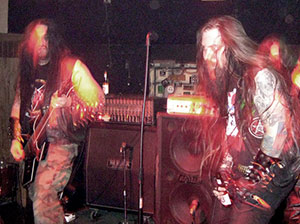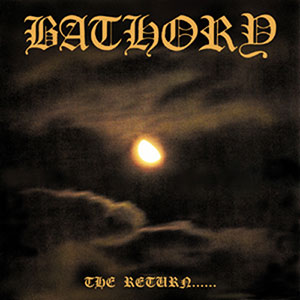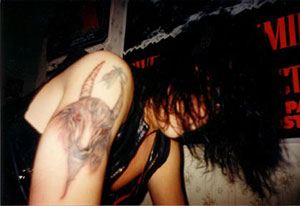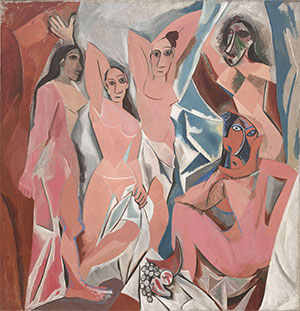“Things that are genuinely sublime speak for themselves.”
 Once upon a time I used to cringe whenever I read interviews with my favorite metal musicians, as no matter how well they started they would almost always lead up to the same sort of question and the same disappointing response. Something along the lines of: “What did you mean by this song/album?” followed by “It’s up to the listener to decide what it means.”
Once upon a time I used to cringe whenever I read interviews with my favorite metal musicians, as no matter how well they started they would almost always lead up to the same sort of question and the same disappointing response. Something along the lines of: “What did you mean by this song/album?” followed by “It’s up to the listener to decide what it means.”
This is a stock response almost across the board in metal (from the brainless to the most inspired of bands) and it used to annoy me. After all the effort I was putting in trying to convince people that metal was a legitimate and thoughtful art-form, whose creators are both articulate and deliberate, it would all be undone in one swift blow by what sounded to me like an under-confident and poorly thought-out response.
Was it embarrassment at talking about their motivations? Or a lack of deliberation over the creative process (which just didn’t seem true at all when I listened to the music)? This kind of off-hand, Hallmark-card relativism belonged in rock & pop, where the music really is an empty vessel for the listener to paste in their own experiences and fantasies, but not in metal.
Surely metal bands didn’t believe this of their own work — that their decision to come to this outsider genre, to innovate and/or fervently uphold an enshrined sense of metalness against a society that wanted to assimilate, emasculate and repackage it, the meandering music and reference-laden lyrics — none of it had any significance outside of whatever the listener felt like, however trivial or stupid?
I now get that I was looking at it wrong. It’s not that the listener gets to choose what the work means, but that they must explore it in order to find its meaning. This is a standard approach toward learning called esotericism, which means simply that the learner advances as his or her own pace, and without that readiness in the listener, more cannot “be taught.”
What they do not need is to be told what it means and how to think about it. Long-winded explanations kill the sense of mystery that’s inherent to good metal. In the same way that reading Quorthon explain how the guitars on Blood Fire Death were recorded in the toilet of a garage kind of dampens the mythical, Viking warrior image of that album, too much talk about the background mental processes that go into any piece of art takes away from actually experiencing the art itself. Things that are genuinely sublime don’t need too much explanation, they speak for themselves.
The nerd in me will always enjoy finding out about how and why something was made the way it was. But unlike, say, cathedral architecture, metal doesn’t really have generations of pedagogical artistic and academic development behind it that a person can study and still be filled with a sense of how awesome it is that human endeavor conspired to make it possible.
Even when there is this kind of background to an art-form, it probably only benefits those of a technical mind to find out about how and why something is done. It’s a bit of a Promethean bargain, in which you lose the sense of wonderment in order to find out how to recreate or add to it. Metal is a relatively young genre of music with murky origins and a strange streak of conservatism about it, combating a world that is at various levels hostile or antithetical yet constantly influxing it with new, clueless people looking to join in and take ownership of it.
Amongst newbies misunderstandings will always abound, and whilst it could be argued that clearer explanation by bands of what their work stands for might stop some of this, the opposite might also be the case.
The inverse of metal is the modern art world, which with its aptly sterile settings (the white walls and straight, squared lines of a typical pretentious art gallery) has decided that the explanations are more important than the quality of the work. A turd in a tin can, a cow sawed in half or a semen-streaked bed can all pass as acceptable art, provided they are accompanied by an essay qualifying the artist’s ‘creative’ decisions.
This is where the likes of Liturgy are approaching metal from – a liberal arts background that name-checks all the right theories and schools, and values the backwards relationship between aesthetics and explanation espoused by modern art. Bands like this show us that some people are only ever going to be interested in using metal as window-dressing for their own social posturing, and that too much intellectual naval-gazing (of which there has been a lot over black metal, although not necessarily by the bands themselves) helps attract the sort who are interested in appearing clever without making anything clever.
Being a hessian does not necessarily mean being caveman thick when it comes to understanding or articulating the genre’s purpose and intentions; but something of metal’s primal energy definitely gets lost in too much chin-stroking, as well as in directing people too much to the source or meaning of it all.
Music although underpinned by logical systems is not an entirely rational process, but a visceral one; which is not to diminish rationalizing things, but to say that ultimately art needs to be this way in order to work as it does – it needs the sense of release from talking about stuff in order to express that which is both inexpressible and more than the sum of the parts.
Similarly, life as a whole is more like a journey than an exam study session; the motives and end-point are never always clear, but the actual act of going on the adventure and finding for oneself how to place things within their context is much more fulfilling than being told by someone else what it’s all supposed to mean.
5 Comments According to
According to  For the past 13 years, Adversary Productions have held an annual showcase of their extreme metal productions in Houston, Texas —
For the past 13 years, Adversary Productions have held an annual showcase of their extreme metal productions in Houston, Texas —  Bathory’s relation to the band’s fanbase is an infected story of contradictory interests concerning very human desires for truth and meaning. Oftentimes fans and creator pulled in opposite directions, fighting over whether to leave the Bathory mask on or reveal Bathory’s inner workings.
Bathory’s relation to the band’s fanbase is an infected story of contradictory interests concerning very human desires for truth and meaning. Oftentimes fans and creator pulled in opposite directions, fighting over whether to leave the Bathory mask on or reveal Bathory’s inner workings. Ironically, many fans have as of recently noted that Quorthon himself tampered with the truth quite deliberately. The iconic Bathory goat – which has become a sort of identity marker among fans – is, according to Quorthon, a collage created out of bits and pieces “from several horror comic magazines”. In fact, the goat is taken from a finished illustration in a book on witches from 1981. It wasn’t until 2007 that the originator, Joseph A. Smith, got to know that his drawings had been used as subject matter for tattoos and the like all around the world for decades. It also turns out that the lyrics and title to Bathory’s “For All Those Who Died” is more or less stolen from a
Ironically, many fans have as of recently noted that Quorthon himself tampered with the truth quite deliberately. The iconic Bathory goat – which has become a sort of identity marker among fans – is, according to Quorthon, a collage created out of bits and pieces “from several horror comic magazines”. In fact, the goat is taken from a finished illustration in a book on witches from 1981. It wasn’t until 2007 that the originator, Joseph A. Smith, got to know that his drawings had been used as subject matter for tattoos and the like all around the world for decades. It also turns out that the lyrics and title to Bathory’s “For All Those Who Died” is more or less stolen from a  Cold minimalist black metal got a bad rap back in the 1990s when people figured out that it had basically taken
Cold minimalist black metal got a bad rap back in the 1990s when people figured out that it had basically taken  The other day I looked up Picasso’s Les Demoiselles d’Avignon. I had seen it before a couple of times and heard it was important. It’s basically some chicks from a brothel with bodies deformed by Pablo’s furious brushstrokes, eyes staring at you uncomfortably and somewhat comically. A painting central to the evolution of Cubism, apparently. The point is that this is where visual art collapsed. The year was 1907; the nightmarish figures of modern art had already been around for decades, but now all traditional assumptions had to be annihilated, paving the way for all modern things to come – for all things post-modern as well. In hindsight, it’s simply the putrefaction of dying tradition doing its job. And we understand you, Pablo; you, the genius, had to show us what this meant, you had to show us the horrors of having no perspective at all. (How do we even start looking at a woman with two and a half arms?) Comedy aside, make no mistake: Les Demoiselles d’Avignon is sheer terror. As such, it suffices, it does what it should – it works. Those disconnected shapes told of all modern art to come, avoiding conformity to the most extreme degree.
The other day I looked up Picasso’s Les Demoiselles d’Avignon. I had seen it before a couple of times and heard it was important. It’s basically some chicks from a brothel with bodies deformed by Pablo’s furious brushstrokes, eyes staring at you uncomfortably and somewhat comically. A painting central to the evolution of Cubism, apparently. The point is that this is where visual art collapsed. The year was 1907; the nightmarish figures of modern art had already been around for decades, but now all traditional assumptions had to be annihilated, paving the way for all modern things to come – for all things post-modern as well. In hindsight, it’s simply the putrefaction of dying tradition doing its job. And we understand you, Pablo; you, the genius, had to show us what this meant, you had to show us the horrors of having no perspective at all. (How do we even start looking at a woman with two and a half arms?) Comedy aside, make no mistake: Les Demoiselles d’Avignon is sheer terror. As such, it suffices, it does what it should – it works. Those disconnected shapes told of all modern art to come, avoiding conformity to the most extreme degree. But finding tradition seems a happy coincidence in this case, or, more likely, something which metal music realized only through sheer necessity. Deliberately reinventing tradition in art isn’t always a good idea. It has been tried before, and in my experience the results are actually worse than a cry in the dark. If we go back to the visual modern arts and look across the spectrum from Picasso’s wild experiments to the opposite side, we find (among others) the Academics, like William-Adolphe Bouguereau. This is from the wow-I-can-definitely-see-what-it-depicts-but-it’s-boring-me-to-tears school of art. It has no urgency. Great art is almost by necessity always inspired by personal experience in the world and time we live in. Trying to remove yourself from it will turn the art into stories about virtually nothing. And that’s what we see in Bouguereau. An artist trained in the old school, with all the craft of tradition but none of the spirit gained from experience. That experience doesn’t need to be one of terror, but giving an artwork weight demands an ability to pick up what is going on around you and inside you. And we are not talking socio-political particularities here, but an existential understanding. What does it mean to be human during this time and this place?
But finding tradition seems a happy coincidence in this case, or, more likely, something which metal music realized only through sheer necessity. Deliberately reinventing tradition in art isn’t always a good idea. It has been tried before, and in my experience the results are actually worse than a cry in the dark. If we go back to the visual modern arts and look across the spectrum from Picasso’s wild experiments to the opposite side, we find (among others) the Academics, like William-Adolphe Bouguereau. This is from the wow-I-can-definitely-see-what-it-depicts-but-it’s-boring-me-to-tears school of art. It has no urgency. Great art is almost by necessity always inspired by personal experience in the world and time we live in. Trying to remove yourself from it will turn the art into stories about virtually nothing. And that’s what we see in Bouguereau. An artist trained in the old school, with all the craft of tradition but none of the spirit gained from experience. That experience doesn’t need to be one of terror, but giving an artwork weight demands an ability to pick up what is going on around you and inside you. And we are not talking socio-political particularities here, but an existential understanding. What does it mean to be human during this time and this place?
